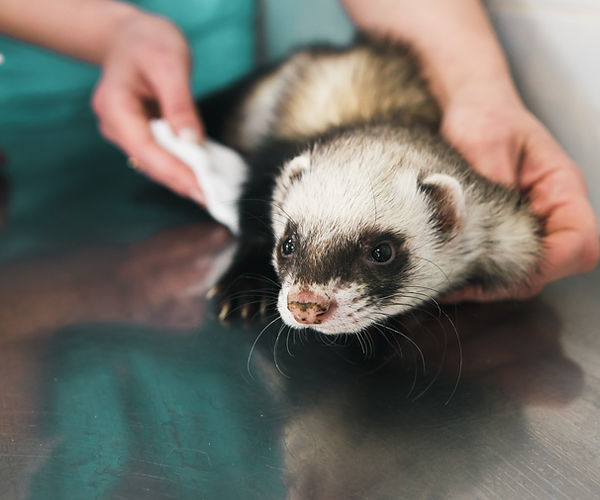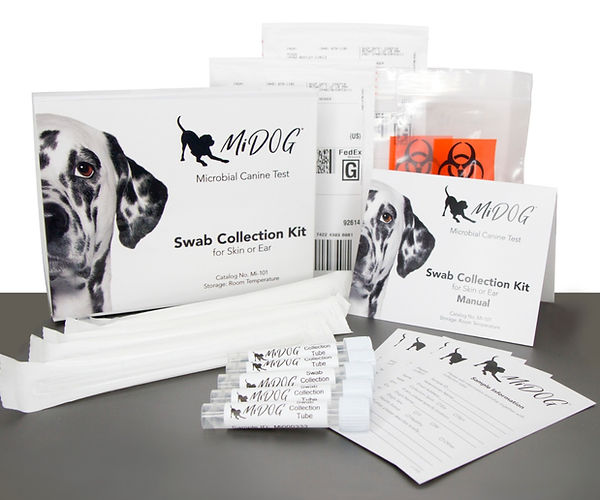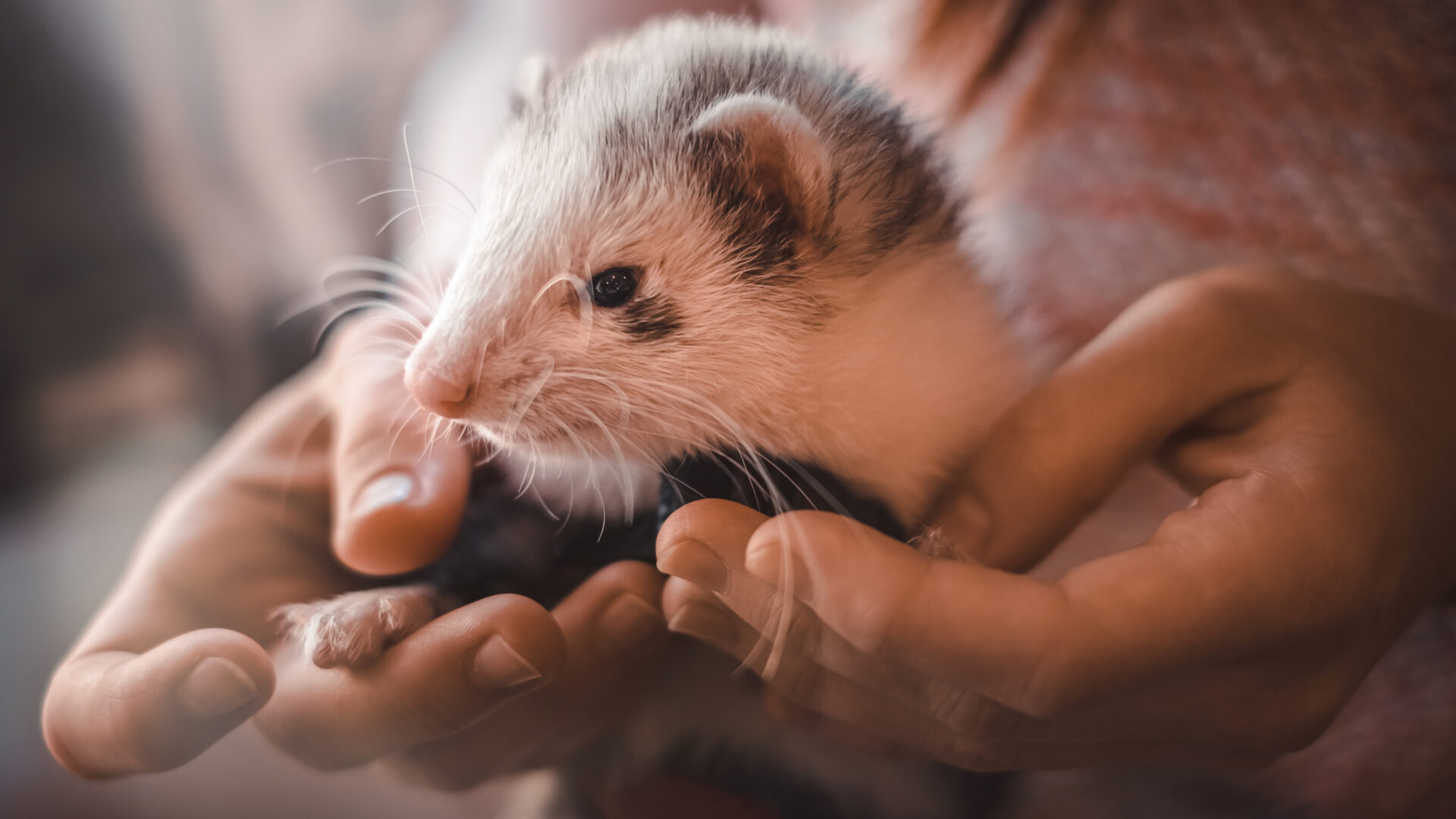
The MiDOG test can help ferrets too!
Fungal infections are never fun, and your ferret agrees! Dermatophytosis, which is a fungal infection of the skin, hair, and/or nails, is particularly common in ferrets [1]. If your ferret seems to have an unusual skin condition, it is worthwhile to take your furry friend to an exotic pet veterinarian since your ferret may have a dermatophytosis infection. Dermatophytosis is uncomfortable but treatable; however, this fungal infection is highly contagious and is a zoonotic disease (meaning it can transmit to humans), and therefore needs to be managed with informed care.
What is a Dermatophytosis?
Dermatophytosis (commonly referred to as ringworm or tinea) is a fungal infection characterized by the presence of dermatophytes, which are a type of fungi that require keratin to grow [1,2]. In ferrets, the most common culprits of dermatophytosis infections are Microsporum canis and Trichophyton mentagrophytes fungi, which are transmitted by direct contact with infected animals or contaminated materials that carry the infection [3]. While the carriers of dermatophytes are often other companion animals, recent studies suggest that animal equipment like brushes, collars, bedding, and more can be sources of infection [2]. This is because dermatophytes are highly resistant in various environments, making recurrence common if the root cause of the infection is not addressed [4].
Symptoms of Dermatophytosis in Ferrets
Dermatophytosis presents most often in young ferrets [1]. The condition typically starts with pus-filled lesions called papules that spread peripherally and is often accompanied with small patches of alopecia. These lesions spread when untreated, inflaming and crusting the skin [3]. Moreover, this inflammation may leave the ferret susceptible to secondary bacterial infections [3]. Subclinical cases of dermatophytosis are common, and so monitoring your ferret (especially if you have multiple living in the same area) is important for your furry friend’s health [1]. Common symptoms of dermatophytosis in ferrets include:
- dandruff
- poor hair coat or hair loss
- reddened and/or darkened skin
- itchiness
- lesions

The image above depicts a ferret visiting an exotic pet veterinarian.
Treating Dermatophytosis In Your Ferret
If you think your ferret may have dermatophytosis, the best thing you can do is get a quick and accurate diagnosis from your exotic pet veterinarian as soon as you notice symptoms. Delay in care puts your furry friend at risk for complications, including radiation of the infection to other parts of the body, hair loss, scarring, and nail deformities [1]. Although some cases of dermatophytosis in ferrets simply resolve, many cases do require interventions such as topical lime sulfur dips or miconazole/chlorhexidine shampoo baths [1]. An antibiotic treatment plan may also be advised. It is important to note that your ferret’s cage, food bowls, bedding, collar, and any other equipment need to be cleaned as part of the treatment plan [2]. Because dermatophytosis can be transmitted to humans, it is important to wear gloves and handle with care.
Diagnosing Dermatophytosis In Your Ferret
Considering the importance of understanding if your ferret’s dermatophytosis is complicated by bacterial infections, diagnostic tools are critical in delivering quality clinical care. Although culture-based techniques have historically been lauded as the convention, scientific research has provided increasing evidence for the diagnostic benefits of Next-Gen Sequencing (NGS) technology. Conventional culture diagnostics have significant limitations in sensitivity to various microorganisms, as many remain undetected by culture methods [5]. The inability of cultures to detect various microorganisms can result in “no growth” cultures despite symptomatic dermatophytosis presentations [5].
Specifically, culturing the causative fungi of dermatophytosis is difficult, because culturing these fungi requires a step known as sedimentation. Various studies have found that “sedimentation is not totally efficient” in separating fungal structures making it difficult to actually perform the culture [6]. Moreover, other studies found that while “positive fungal cultures may offer proof of infection, negative cultures are less definitive” [1]. Consequently, NGS has increasingly been used to diagnose fungal infections in ferrets. For example, one study identifying the environmental source of infection for a domestic ferret with cryptococcosis found a wide range of fungal and bacterial contaminants that had previously been reported absent due to negative cultures [8].
The MiDOG All-in-One microbiome test may provide the answer to the diagnostic conundrum that dermatophytosis poses on your furry friend. Utilizing NGS technology to detect and quantify all microbial DNA through untargeted and comprehensive sequencing and quantitative comparisons to reference databases, the MiDOG NGS technology provides a useful opportunity to shed light on the microbial and mycobial makeup of your ferret’s infection for clinical application. The MiDOG microbiome test is a microbial identification test grounded on scientific research that provides veterinarians DNA evidence for the guided treatment of ferret infections, such as dermatophytosis.

The MiDOG Swab Collection Kit
Find out if your vet uses MiDOG before you book your next appointment!
References:
[1] Moriello, K., Coyner, K., Paterson, S., & Mignon, B. (2017). Diagnosis and treatment of dermatophytosis in dogs and cats. Veterinary Dermatology, 28(3), 266-e68. doi: 10.1111/vde.12440
[2] Morrisey, J. (2020). Infectious Diseases of Ferrets. Retrieved from https://www.merckvetmanual.com/all-other-pets/ferrets/infectious-diseases-of-ferrets
[3] Wolf T. M. (2009). FERRETS. Manual of Exotic Pet Practice, 345–374. https://doi.org/10.1016/B978-141600119-5.50016-0
[4] Dworecka-Kaszak, B., Biegańska, M.J. & Dąbrowska, I. Occurrence of various pathogenic and opportunistic fungi in skin diseases of domestic animals: a retrospective study. BMC Vet Res 16, 248 (2020). https://doi.org/10.1186/s12917-020-02460-x
[5] Krumbreck, J., 2021. Canine Urin Microbiome: Assessment of Bacterial and Fungal Populations in Clinically Healthy Dogs Using Next-Generation-Sequencing. Journal of Veterinary Internal Medicine.
[6] Aneke, C. I., Otranto, D., & Cafarchia, C. (2018). Therapy and Antifungal Susceptibility Profile of Microsporum canis. Journal of fungi (Basel, Switzerland), 4(3), 107. https://doi.org/10.3390/jof4030107
[7] Schmertmann, L. J., Wardman, A., Setyo, L., Kan, A., Meyer, W., Malik, R., & Krockenberger, M. B. (2019). Identification of the environmental source of infection for a domestic ferret with cryptococcosis. Journal of veterinary diagnostic investigation : official publication of the American Association of Veterinary Laboratory Diagnosticians, Inc, 31(6), 828–835. https://doi.org/10.1177/1040638719876968
Categories: Ferrets, Fungal Infections, Next-Gen DNA Sequencing Technology, Skin Health

